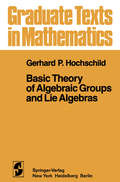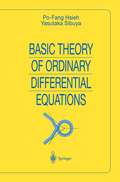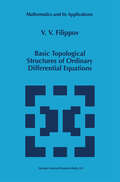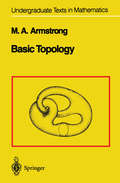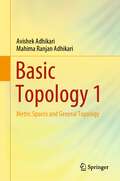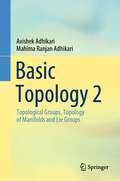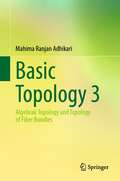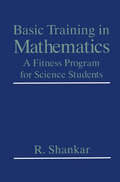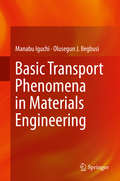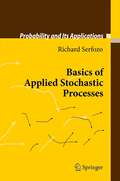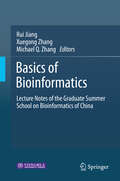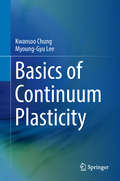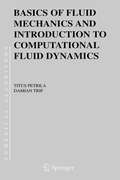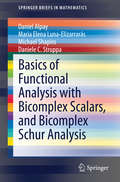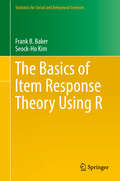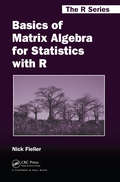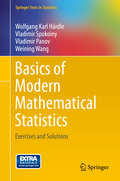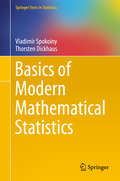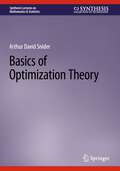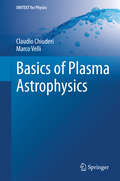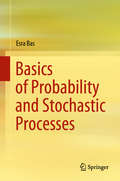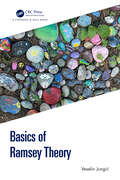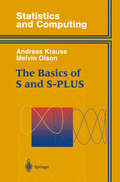- Table View
- List View
Basic Theory of Algebraic Groups and Lie Algebras (Graduate Texts in Mathematics #75)
by G. P. HochschildThe theory of algebraic groups results from the interaction of various basic techniques from field theory, multilinear algebra, commutative ring theory, algebraic geometry and general algebraic representation theory of groups and Lie algebras. It is thus an ideally suitable framework for exhibiting basic algebra in action. To do that is the principal concern of this text. Accordingly, its emphasis is on developing the major general mathematical tools used for gaining control over algebraic groups, rather than on securing the final definitive results, such as the classification of the simple groups and their irreducible representations. In the same spirit, this exposition has been made entirely self-contained; no detailed knowledge beyond the usual standard material of the first one or two years of graduate study in algebra is pre supposed. The chapter headings should be sufficient indication of the content and organisation of this book. Each chapter begins with a brief announcement of its results and ends with a few notes ranging from supplementary results, amplifications of proofs, examples and counter-examples through exercises to references. The references are intended to be merely suggestions for supplementary reading or indications of original sources, especially in cases where these might not be the expected ones. Algebraic group theory has reached a state of maturity and perfection where it may no longer be necessary to re-iterate an account of its genesis. Of the material to be presented here, including much of the basic support, the major portion is due to Claude Chevalley.
Basic Theory of Ordinary Differential Equations (Universitext)
by Po-Fang Hsieh Yasutaka SibuyaProviding readers with the very basic knowledge necessary to begin research on differential equations with professional ability, the selection of topics here covers the methods and results that are applicable in a variety of different fields. The book is divided into four parts. The first covers fundamental existence, uniqueness, smoothness with respect to data, and nonuniqueness. The second part describes the basic results concerning linear differential equations, while the third deals with nonlinear equations. In the last part the authors write about the basic results concerning power series solutions. Each chapter begins with a brief discussion of its contents and history, and hints and comments for many problems are given throughout. With 114 illustrations and 206 exercises, the book is suitable for a one-year graduate course, as well as a reference book for research mathematicians.
Basic Topological Structures of Ordinary Differential Equations (Mathematics and Its Applications #432)
by V.V. FilippovThe aim of this book is a detailed study of topological effects related to continuity of the dependence of solutions on initial values and parameters. This allows us to develop cheaply a theory which deals easily with equations having singularities and with equations with multivalued right hand sides (differential inclusions). An explicit description of corresponding topological structures expands the theory in the case of equations with continuous right hand sides also. In reality, this is a new science where Ordinary Differential Equations, General Topology, Integration theory and Functional Analysis meet. In what concerns equations with discontinuities and differential inclu sions, we do not restrict the consideration to the Cauchy problem, but we show how to develop an advanced theory whose volume is commensurable with the volume of the existing theory of Ordinary Differential Equations. The level of the account rises in the book step by step from second year student to working scientist.
Basic Topology (Undergraduate Texts in Mathematics)
by M.A. ArmstrongIn this broad introduction to topology, the author searches for topological invariants of spaces, together with techniques for their calculating. Students with knowledge of real analysis, elementary group theory, and linear algebra will quickly become familiar with a wide variety of techniques and applications involving point-set, geometric, and algebraic topology. Over 139 illustrations and more than 350 problems of various difficulties help students gain a thorough understanding of the subject.
Basic Topology 1: Metric Spaces and General Topology
by Avishek Adhikari Mahima Ranjan AdhikariThis first of the three-volume book is targeted as a basic course in topology for undergraduate and graduate students of mathematics. It studies metric spaces and general topology. It starts with the concept of the metric which is an abstraction of distance in the Euclidean space. The special structure of a metric space induces a topology that leads to many applications of topology in modern analysis and modern algebra, as shown in this volume. This volume also studies topological properties such as compactness and connectedness. Considering the importance of compactness in mathematics, this study covers the Stone–Cech compactification and Alexandroff one-point compactification. This volume also includes the Urysohn lemma, Urysohn metrization theorem, Tietz extension theorem, and Gelfand–Kolmogoroff theorem. The content of this volume is spread into eight chapters of which the last chapter conveys the history of metric spaces and the history of the emergence of the concepts leading to the development of topology as a subject with their motivations with an emphasis on general topology. It includes more material than is comfortably covered by beginner students in a one-semester course. Students of advanced courses will also find the book useful. This book will promote the scope, power, and active learning of the subject, all the while covering a wide range of theories and applications in a balanced unified way.
Basic Topology 2: Topological Groups, Topology of Manifolds and Lie Groups
by Avishek Adhikari Mahima Ranjan AdhikariThis second of the three-volume book is targeted as a basic course in topology for undergraduate and graduate students of mathematics. It focuses on many variants of topology and its applications in modern analysis, geometry, algebra, and the theory of numbers. Offering a proper background on topology, analysis, and algebra, this volume discusses the topological groups and topological vector spaces that provide many interesting geometrical objects which relate algebra with geometry and analysis. This volume follows a systematic and comprehensive elementary approach to the topology related to manifolds, emphasizing differential topology. It further communicates the history of the emergence of the concepts leading to the development of topological groups, manifolds, and also Lie groups as mathematical topics with their motivations. This book will promote the scope, power, and active learning of the subject while covering a wide range of theories and applications in a balanced unified way.
Basic Topology 3: Algebraic Topology and Topology of Fiber Bundles
by Mahima Ranjan AdhikariThis third of the three-volume book is targeted as a basic course in algebraic topology and topology for fiber bundles for undergraduate and graduate students of mathematics. It focuses on many variants of topology and its applications in modern analysis, geometry, and algebra. Topics covered in this volume include homotopy theory, homology and cohomology theories, homotopy theory of fiber bundles, Euler characteristic, and the Betti number. It also includes certain classic problems such as the Jordan curve theorem along with the discussions on higher homotopy groups and establishes links between homotopy and homology theories, axiomatic approach to homology and cohomology as inaugurated by Eilenberg and Steenrod. It includes more material than is comfortably covered by beginner students in a one-semester course. Students of advanced courses will also find the book useful. This book will promote the scope, power and active learning of the subject, all the while covering a wide range of theory and applications in a balanced unified way.
Basic Training in Mathematics: A Fitness Program for Science Students
by R. ShankarBased on course material used by the author at Yale University, this practical text addresses the widening gap found between the mathematics required for upper-level courses in the physical sciences and the knowledge of incoming students. This superb book offers students an excellent opportunity to strengthen their mathematical skills by solving various problems in differential calculus. By covering material in its simplest form, students can look forward to a smooth entry into any course in the physical sciences.
Basic Transport Phenomena in Materials Engineering
by Manabu Iguchi Olusegun J. IlegbusiThis book presents the basic theory and experimental techniques of transport phenomena in materials processing operations. Such fundamental knowledge is highly useful for researchers and engineers in the field to improve the efficiency of conventional processes or develop novel technology. Divided into four parts, the book comprises 11 chapters describing the principles of momentum transfer, heat transfer, and mass transfer in single phase and multiphase systems. Each chapter includes examples with solutions and exercises to facilitate students’ learning. Diagnostic problems are also provided at the end of each part to assess students’ comprehension of the material. The book is aimed primarily at students in materials science and engineering. However, it can also serve as a useful reference text in chemical engineering as well as an introductory transport phenomena text in mechanical engineering. In addition, researchers and engineers engaged in materials processing operations will find the material useful for the design of experiments and mathematical models in transport phenomena. This volume contains unique features not usually found in traditional transport phenomena texts. It integrates experimental techniques and theory, both of which are required to adequately solve the inherently complex problems in materials processing operations. It takes a holistic approach by considering both single and multiphase systems, augmented with specific practical examples. There is a discussion of flow and heat transfer in microscale systems, which is relevant to the design of modern processes such as fuel cells and compact heat exchangers. Also described are auxiliary relationships including turbulence modeling, interfacial phenomena, rheology, and particulate systems, which are critical to many materials processing operations.
Basics of Applied Stochastic Processes (Probability and Its Applications)
by Richard SerfozoStochastic processes are mathematical models of random phenomena that evolve according to prescribed dynamics. Processes commonly used in applications are Markov chains in discrete and continuous time, renewal and regenerative processes, Poisson processes, and Brownian motion. This volume gives an in-depth description of the structure and basic properties of these stochastic processes. A main focus is on equilibrium distributions, strong laws of large numbers, and ordinary and functional central limit theorems for cost and performance parameters. Although these results differ for various processes, they have a common trait of being limit theorems for processes with regenerative increments. Extensive examples and exercises show how to formulate stochastic models of systems as functions of a system’s data and dynamics, and how to represent and analyze cost and performance measures. Topics include stochastic networks, spatial and space-time Poisson processes, queueing, reversible processes, simulation, Brownian approximations, and varied Markovian models. The technical level of the volume is between that of introductory texts that focus on highlights of applied stochastic processes, and advanced texts that focus on theoretical aspects of processes.
Basics of Bioinformatics: Lecture Notes of the Graduate Summer School on Bioinformatics of China
by Rui Jiang, Xuegong Zhang and Michael Q. ZhangThis book outlines 11 courses and 15 research topics in bioinformatics, based on curriculums and talks in a graduate summer school on bioinformatics that was held in Tsinghua University. The courses include: Basics for Bioinformatics, Basic Statistics for Bioinformatics, Topics in Computational Genomics, Statistical Methods in Bioinformatics, Algorithms in Computational Biology, Multivariate Statistical Methods in Bioinformatics Research, Association Analysis for Human Diseases: Methods and Examples, Data Mining and Knowledge Discovery Methods with Case Examples, Applied Bioinformatics Tools, Foundations for the Study of Structure and Function of Proteins, Computational Systems Biology Approaches for Deciphering Traditional Chinese Medicine, and Advanced Topics in Bioinformatics and Computational Biology. This book can serve as not only a primer for beginners in bioinformatics, but also a highly summarized yet systematic reference book for researchers in this field.Rui Jiang and Xuegong Zhang are both professors at the Department of Automation, Tsinghua University, China. Professor Michael Q. Zhang works at the Cold Spring Harbor Laboratory, Cold Spring Harbor, NY, USA.
Basics of Continuum Plasticity
by Kwansoo Chung Myoung-Gyu LeeThis book describes the basic principles of plasticity for students and engineers who wish to perform plasticity analyses in their professional lives, and provides an introduction to the application of plasticity theories and basic continuum mechanics in metal forming processes. This book consists of three parts. The first part deals with the characteristics of plasticity and instability under simple tension or compression and plasticity in beam bending and torsion. The second part is designed to provide the basic principles of continuum mechanics, and the last part presents an extension of one-dimensional plasticity to general three-dimensional laws based on the fundamentals of continuum mechanics. Though most parts of the book are written in the context of general plasticity, the last two chapters are specifically devoted to sheet metal forming applications. The homework problems included are designed to reinforce understanding of the concepts involved. This book may be used as a textbook for a one semester course lasting fourteen weeks or longer. This book is intended to be self-sufficient such that readers can study it independently without taking another formal course. However, there are some prerequisites before starting this book, which include a course on engineering mathematics and an introductory course on solid mechanics.
Basics of Fluid Mechanics and Introduction to Computational Fluid Dynamics (Numerical Methods and Algorithms #3)
by Titus Petrila Damian TrifThe present book – through the topics and the problems approach – aims at filling a gap, a real need in our literature concerning CFD (Computational Fluid Dynamics). Our presentation results from a large documentation and focuses on reviewing the present day most important numerical and computational methods in CFD. Many theoreticians and experts in the field have expressed their - terest in and need for such an enterprise. This was the motivation for carrying out our study and writing this book. It contains an important systematic collection of numerical working instruments in Fluid Dyn- ics. Our current approach to CFD started ten years ago when the Univ- sity of Paris XI suggested a collaboration in the field of spectral methods for fluid dynamics. Soon after – preeminently studying the numerical approaches to Navier–Stokes nonlinearities – we completed a number of research projects which we presented at the most important inter- tional conferences in the field, to gratifying appreciation. An important qualitative step in our work was provided by the dev- opment of a computational basis and by access to a number of expert softwares. This fact allowed us to generate effective working programs for most of the problems and examples presented in the book, an - pect which was not taken into account in most similar studies that have already appeared all over the world.
Basics of Functional Analysis with Bicomplex Scalars, and Bicomplex Schur Analysis (SpringerBriefs in Mathematics)
by Daniel Alpay Maria Elena Luna-Elizarrarás Michael Shapiro Daniele C. StruppaThis book provides the foundations for a rigorous theory of functional analysis with bicomplex scalars. It begins with a detailed study of bicomplex and hyperbolic numbers and then defines the notion of bicomplex modules. After introducing a number of norms and inner products on such modules (some of which appear in this volume for the first time), the authors develop the theory of linear functionals and linear operators on bicomplex modules. All of this may serve for many different developments, just like the usual functional analysis with complex scalars and in this book it serves as the foundational material for the construction and study of a bicomplex version of the well known Schur analysis.
The Basics of Item Response Theory Using R (Statistics for Social and Behavioral Sciences)
by Frank B. Baker Seock-Ho KimThis graduate-level textbook is a tutorial for item response theory that covers both the basics of item response theory and the use of R for preparing graphical presentation in writings about the theory. Item response theory has become one of the most powerful tools used in test construction, yet one of the barriers to learning and applying it is the considerable amount of sophisticated computational effort required to illustrate even the simplest concepts. This text provides the reader access to the basic concepts of item response theory freed of the tedious underlying calculations. It is intended for those who possess limited knowledge of educational measurement and psychometrics.Rather than presenting the full scope of item response theory, this textbook is concise and practical and presents basic concepts without becoming enmeshed in underlying mathematical and computational complexities. Clearly written text and succinct R code allow anyone familiar with statistical concepts to explore and apply item response theory in a practical way. In addition to students of educational measurement, this text will be valuable to measurement specialists working in testing programs at any level and who need an understanding of item response theory in order to evaluate its potential in their settings.
Basics of Matrix Algebra for Statistics with R (Chapman & Hall/CRC The R Series)
by Nick FiellerA Thorough Guide to Elementary Matrix Algebra and Implementation in R Basics of Matrix Algebra for Statistics with R provides a guide to elementary matrix algebra sufficient for undertaking specialized courses, such as multivariate data analysis and linear models. It also covers advanced topics, such as generalized inverses of singular and rectangular matrices and manipulation of partitioned matrices, for those who want to delve deeper into the subject. The book introduces the definition of a matrix and the basic rules of addition, subtraction, multiplication, and inversion. Later topics include determinants, calculation of eigenvectors and eigenvalues, and differentiation of linear and quadratic forms with respect to vectors. The text explores how these concepts arise in statistical techniques, including principal component analysis, canonical correlation analysis, and linear modeling. In addition to the algebraic manipulation of matrices, the book presents numerical examples that illustrate how to perform calculations by hand and using R. Many theoretical and numerical exercises of varying levels of difficulty aid readers in assessing their knowledge of the material. Outline solutions at the back of the book enable readers to verify the techniques required and obtain numerical answers. Avoiding vector spaces and other advanced mathematics, this book shows how to manipulate matrices and perform numerical calculations in R. It prepares readers for higher-level and specialized studies in statistics.
Basics of Matrix Algebra for Statistics with R (Chapman & Hall/CRC The R Series #31)
by Nick FiellerA Thorough Guide to Elementary Matrix Algebra and Implementation in R Basics of Matrix Algebra for Statistics with R provides a guide to elementary matrix algebra sufficient for undertaking specialized courses, such as multivariate data analysis and linear models. It also covers advanced topics, such as generalized inverses of singular and rectangular matrices and manipulation of partitioned matrices, for those who want to delve deeper into the subject. The book introduces the definition of a matrix and the basic rules of addition, subtraction, multiplication, and inversion. Later topics include determinants, calculation of eigenvectors and eigenvalues, and differentiation of linear and quadratic forms with respect to vectors. The text explores how these concepts arise in statistical techniques, including principal component analysis, canonical correlation analysis, and linear modeling. In addition to the algebraic manipulation of matrices, the book presents numerical examples that illustrate how to perform calculations by hand and using R. Many theoretical and numerical exercises of varying levels of difficulty aid readers in assessing their knowledge of the material. Outline solutions at the back of the book enable readers to verify the techniques required and obtain numerical answers. Avoiding vector spaces and other advanced mathematics, this book shows how to manipulate matrices and perform numerical calculations in R. It prepares readers for higher-level and specialized studies in statistics.
Basics of Modern Mathematical Statistics: Exercises and Solutions (Springer Texts in Statistics)
by Wolfgang Karl Härdle Vladimir Spokoiny Vladimir Panov Weining WangThe complexity of today’s statistical data calls for modern mathematical tools. Many fields of science make use of mathematical statistics and require continuous updating on statistical technologies. Practice makes perfect, since mastering the tools makes them applicable. Our book of exercises and solutions offers a wide range of applications and numerical solutions based on R.In modern mathematical statistics, the purpose is to provide statistics students with a number of basic exercises and also an understanding of how the theory can be applied to real-world problems.The application aspect is also quite important, as most previous exercise books are mostly on theoretical derivations. Also we add some problems from topics often encountered in recent research papers.The book was written for statistics students with one or two years of coursework in mathematical statistics and probability, professors who hold courses in mathematical statistics, and researchers in other fields who would like to do some exercises on math statistics.
Basics of Modern Mathematical Statistics: Exercises And Solutions (Springer Texts in Statistics)
by Vladimir Spokoiny Thorsten DickhausThis textbook provides a unified and self-contained presentation of the main approaches to and ideas of mathematical statistics. It collects the basic mathematical ideas and tools needed as a basis for more serious study or even independent research in statistics. The majority of existing textbooks in mathematical statistics follow the classical asymptotic framework. Yet, as modern statistics has changed rapidly in recent years, new methods and approaches have appeared. The emphasis is on finite sample behavior, large parameter dimensions, and model misspecifications. The present book provides a fully self-contained introduction to the world of modern mathematical statistics, collecting the basic knowledge, concepts and findings needed for doing further research in the modern theoretical and applied statistics. This textbook is primarily intended for graduate and postdoc students and young researchers who are interested in modern statistical methods.
Basics of Optimization Theory (Synthesis Lectures on Mathematics & Statistics)
by Arthur David SniderThis book presents a short introduction to the main tools of optimization methodology including linear programming, steepest descent, conjugate gradients, and the Karush-Kuhn-Tucker-John conditions. Each topic is developed in terms of a specific physical model, so that the strategy behind every step is motivated by a logical, concrete, easily visualized objective. A quick perusal of the Fibonacci search algorithm provides a simple and tantalizing first encounter with optimization theory, and a review of the max-min exposition of one-dimensional calculus prepares readers for the more sophisticated topics found later in the book. Notable features are the innovative perspectives on the simplex algorithm and Karush-Kuhn-Tucker-John conditions as well as a wealth of helpful diagrams. The author provides pointers to references for readers who would like to learn more about rigorous definitions, proofs, elegant reformulations and extensions, and case studies. However, the book is sufficiently self-contained to serve as a reliable resource for readers who wish to exploit commercially available optimization software without investing the time to develop expertise in its aspects.This book also:Features innovative perspectives on the simplex algorithm and Krushal-Kuhn-Tucker-John conditionsServes as a resource for readers to use the tools of optimization without needing to acquire expertise in the theoryFeatures plentiful resources that focus on rigorous definitions, proofs, and case studies
Basics of Plasma Astrophysics (UNITEXT for Physics)
by Claudio Chiuderi Marco VelliThis book is an introduction to contemporary plasma physics that discusses the most relevant recent advances in the field and covers a careful choice of applications to various branches of astrophysics and space science. The purpose of the book is to allow the student to master the basic concepts of plasma physics and to bring him or her up to date in a number of relevant areas of current research. Topics covered include orbit theory, kinetic theory, fluid models, magnetohydrodynamics, MHD turbulence, instabilities, discontinuities, and magnetic reconnection. Some prior knowledge of classical physics is required, in particular fluid mechanics, statistical physics, and electrodynamics. The mathematical developments are self-contained and explicitly detailed in the text. A number of exercises are provided at the end of each chapter, together with suggestions and solutions.
Basics of Probability and Stochastic Processes
by Esra BasThis textbook explores probability and stochastic processes at a level that does not require any prior knowledge except basic calculus. It presents the fundamental concepts in a step-by-step manner, and offers remarks and warnings for deeper insights. The chapters include basic examples, which are revisited as the new concepts are introduced. To aid learning, figures and diagrams are used to help readers grasp the concepts, and the solutions to the exercises and problems. Further, a table format is also used where relevant for better comparison of the ideas and formulae. The first part of the book introduces readers to the essentials of probability, including combinatorial analysis, conditional probability, and discrete and continuous random variable. The second part then covers fundamental stochastic processes, including point, counting, renewal and regenerative processes, the Poisson process, Markov chains, queuing models and reliability theory. Primarily intended for undergraduate engineering students, it is also useful for graduate-level students wanting to refresh their knowledge of the basics of probability and stochastic processes.
Basics of Ramsey Theory
by Veselin JungićBasics of Ramsey Theory serves as a gentle introduction to Ramsey theory for students interested in becoming familiar with a dynamic segment of contemporary mathematics that combines ideas from number theory and combinatorics. The core of the of the book consists of discussions and proofs of the results now universally known as Ramsey’s theorem, van der Waerden’s theorem, Schur’s theorem, Rado’s theorem, the Hales–Jewett theorem, and the Happy End Problem of Erdős and Szekeres. The aim is to present these in a manner that will be challenging but enjoyable, and broadly accessible to anyone with a genuine interest in mathematics. Features Suitable for any undergraduate student who has successfully completed the standard calculus sequence of courses and a standard first (or second) year linear algebra course. Filled with visual proofs of fundamental theorems. Contains numerous exercises (with their solutions) accessible to undergraduate students. Serves as both a textbook or as a supplementary text in an elective course in combinatorics and aimed at a diverse group of students interested in mathematics.
Basics of Ramsey Theory
by Veselin JungićBasics of Ramsey Theory serves as a gentle introduction to Ramsey theory for students interested in becoming familiar with a dynamic segment of contemporary mathematics that combines ideas from number theory and combinatorics. The core of the of the book consists of discussions and proofs of the results now universally known as Ramsey’s theorem, van der Waerden’s theorem, Schur’s theorem, Rado’s theorem, the Hales–Jewett theorem, and the Happy End Problem of Erdős and Szekeres. The aim is to present these in a manner that will be challenging but enjoyable, and broadly accessible to anyone with a genuine interest in mathematics. Features Suitable for any undergraduate student who has successfully completed the standard calculus sequence of courses and a standard first (or second) year linear algebra course. Filled with visual proofs of fundamental theorems. Contains numerous exercises (with their solutions) accessible to undergraduate students. Serves as both a textbook or as a supplementary text in an elective course in combinatorics and aimed at a diverse group of students interested in mathematics.
The Basics of S and S-PLUS (Statistics and Computing)
by Andreas Krause Melvin OlsonThe basics of S-PLUS written in a clear style at a level suitable for people with little computing or statistical knowledge. Unlike the S-PLUS manuals, this is not comprehensive, but instead introduces the most important ideas of S-PLUS by way of many examples. Each chapter also includes a collection of exercises which are accompanied by fully worked-out solutions and detailed comments. The whole is rounded off with practical hints on how efficient work can be performed in S-PLUS, and is thus well-suited for self-study and as a textbook.
